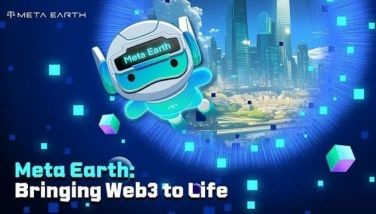Sandman Hearts The Dork Knight
I have been a horrendously rabid comic book fan since before I developed hair in my erogenous zones. I have spent enough money on my comic book collection to pay for a presidential campaign. I know the history of the DC Comics Universe better than I know Philippine history. And I mark significant moments in my life — like marriage and the birth of my baby daughter — by what issue of the Justice League of America came out that month.
When I discovered that Neil Gaiman would be materializing in the Philippines for the awarding ceremony of “Revelations: Stories of Light and Darkness, the Third Philippine Graphic/Fiction Awards Night” organized and sponsored by Fully Booked, I threatened to rally outside every day dressed in a mask, cape and underwear outside of my pants unless I got to interview the prolific author of such books as American Gods, Coraline, Stardust, Good Omens, Neverwhere, The Wolves in the Wall, The Day I Swapped My Dad for Two Goldfish . And, of course, Sandman.
Neil famously described his work on Sandman, over a period of nine years and 2,000 pages, in one sentence: “The Lord of Dreams learns to change or die, and has to make a decision.”
In an interview conducted at the Edades model unit in the Rockwell Power Plant, Neil shared his thoughts on what makes him incredibly happy, the greatness of our Filipino komiks talent, and why we may never see another Sandman story again.
PHILIPPINE STAR: When you first came to the Philippines in 2005, you mentioned at a writer’s workshop your admiration for several Filipino artists who had made it big in the US comic book industry — Nestor Redondo, Alfredo Alcala and Alex Nino. You described their art as “beautiful line work, elegant lines, beauty and proportion, a sense of quirkiness and beauty.” Did their artistic style influence the themes that you have explored in your comic book and prose works?
NEIL GAIMAN: I honestly don’t know. (Laughs) Because that’s the kind of thing when you say “What would you have been like if you had not met this woman?”, “If you had not seen this art?” or “If you had not read this story?” You don’t know. But the enormous effect that these artists had on me was that it gave me a respect for the Philippines. When I first came here, these artists were all I knew about the country. I knew nothing about Filipino culture, I knew almost nothing about Filipino politics.
That might actually be a good thing.
I knew almost nothing about Filipino history. But what I knew was that this was the country here Alex Nino and Tony de Zuniga and Alfredo Alcala and all these artists came from. They were some of the people who got me through my teens. I liked at how Alfredo crosshatched, he came up with the whole technique of crosshatching of one way and then crosshatching the other way. That was his line work. Looking at things like Alex Nino’s retelling of (Harlan Ellison’s short story) “Repent, Harlequin! Said the Tick-Tock Man.” This was glorious artwork, and these were guys were so good. And I honestly don’t know that I would have started this whole Philippine Graphic/Fiction Awards contest if it hadn’t been for those guys, in some ways.
Those guys were really the pioneers who brought Filipino comic art to a global audience. It’s a shame they aren’t as popular as they should be back here in their homeland.
When I came out here, everyone was telling me that being a (fiction/comic book writer) is so cool in America and in England. “But here in the Philippines, we don’t really do that fiction of comic ‘stuff.’” I said, “What do you mean you don’t do it? You started it!” Some of the greatest artists (from the medium) came from here. What was strange during that period was that when I’d say this, people would say “Really?” I’d ask “Have you heard about Alex Nino?” And they would say “No.”
Shocking, isn’t it?
It really is. I hope that one of the little things that I got to do as part of the strange cultural exchange that has been going on between me and the Philippines for the last five years is actually to remind the Filipinos that some of the greatest artists in comics in the latter half of the century came from here.
Interestingly enough, many of these “classic” artists were influenced by the work of the late great Francisco Coching, who was a pillar in the local komiks industry and was known as the dean of Philippine comics. In fact, he was twice nominated as a National Artist for the Visual Arts. How many nominees for National Artists do you know from the comic book profession?
Awesome! I love the respect with which (art) is still held out here. Among the local comic book creators, I find Gerry Alanguilan’s Elmer is one of my favorite comics. It’s just heartbreaking and funny and so beautifully drawn.
What do you think of our younger crop of komiks creators?
I love Arnold Arre’s stuff (Arnold is the creator of The Mythology Class, Trip to Tagaytay and Ang Mundo ni Andong Agimat). In fact, when I first came out here I kept running into Arnold’s art. I told Jaime (Daez, owner of Fully Booked) “I really want to meet this guy. He’s really good.” And I kept failing to meet Arnold until we were in the toilet together.
There’s a story somewhere there for both you and Arnold. Did you also like Budjette Tan’s Trese?
I really liked it. What I’m really enjoying right now is that people from the Philippines send me and give me comics. This makes me happy. And I just love the fact that these are comics using Philippine culture and folklore. One of the things I really love about the contest is the feeling that I got to point out to people that this stuff is cool. Because when I first came out here, people were giving me books of local folklore and I was reading them. And I was loving them. People would then ask me, “What do you like?” and I would tell them “I liked the aswangs and the manananggals.” After that, they would ask me if I would put them in my stories. Then I started feeling as if I did (write about them) it would lend them some kind of legitimacy, but I would be like a cultural tourist. But what about you guys? This stuff is yours!
Everybody’s got their neighborhood manananggal.
This is incredibly fertile ground. Why aren’t you using it? And one of the things that I love in the (local) comics that I’ve seeing — and more and more in the stories — is the feeling that they are not only using the folklore but they are using the culture around. You’re getting really good, angry, smart, satirical science fiction, you’re getting heartbreaking little horror stories, you’re getting smart social commentary like the Cherry Clubbing story (by Kerry Yu, third place winner in the prose category of this year’s contest). I love it, because it’s talking essentially about sexual tourism of the worst kind and then taking it over into myth. And it’s a beautiful story of outrage and it’s all the voice that it’s told in. Filipina: The Super Maid (by Irene Carolina Sarmiento, second place winner in the prose category), great little story, so angry and so funny. The idea of pointing out that — for some of the world and here in the Philippines — people can be product and just how wrong that is. And what happens when the people that are product become people again.
After reading the works of all the winners in the contest and the current comic book professionals working for US comics — Leinil Francis Yu, Harvey Tolibao, Whilce Portacio — what do you see as the emerging voice of the Filipino in contributing to the global comic and prose community?
When I was here five years ago and I would talk to Filipinos — artists, writers, creators — it was as if I was talking to people who felt that they were at the bottom of a gravity hole. That, from a cultural standpoint, making it out of the gravity pit that was the Philippines and into the rest of the world was so impossible that it simply wouldn’t happen. But what I am seeing more now is that Filipino creators are out there and they are out there as themselves. You don’t get the feeling that people are pretending to be American or English. You now get the feeling that there are brilliant Filipino writers who are willing to write science fiction, fantasy, horror, magical realism, real imaginative stuff and draw and create their own comics. And they are going to it as Filipinos going head-to-head with anybody else in the world.
Just what is in the water in the UK that makes you guys so damn brilliant? Do you have some muses chained up in your basements?
For me, the key to it is that whenever I get together with Alan or Grant, we never talk about comics. We talk about poetry or movies or plays or sociology or whatever’s caught our attention. With Alan, it’s snake gods and local history. I think we all came along from the same kind of “time zone” where a generation read American comic books and thought “These things are brilliant! Imagine what they could be.” And then went off to do another things and kept growing up.
Like how you went off to write the biography of Duran Duran. (Really.)
And when we were offered the chance to do American comics, we went “Oh my God! Those things that we thought you could do, those things that we thought this thing could be, it could! Why don’t we go and make it?” Each of us got to reinvent comics in our own image. I love what Grant does. I love what Alan does. And I love the fact that, as we get older, we all get crankier. (Laughs) We all go off and explore other things and are less concerned whether or not people will like things. For example, I loved doing Metamorpho in Wednesday Comics. I can’t imagine having done that 15 years ago. When I went into it, I thought I’d do a comic that was going to be a goofy sort of tribute to the Bob Haney and Ramona Fradon and I’m going to do it as if it’s set in 1965 in a world wherein Metamorpho was the biggest comic out there instead of being this strange little forgotten hero. The idea just made me incredibly happy that I’d be doing this thing that people would think “This is so strange and so quirky and so odd” and some people would go “They are mad.” I didn’t really mind. It made me happy to do it just as it made me happy to hold Batman’s funeral.
Why do you think you’ve been so successful in all these mediums?
I think it’s because that was what I was interested in doing. I wanted to keep moving. The entire nature of my career has been: Given the choice between two things that I could be doing, one of which I know how to do and have and I have an audience waiting and I am guaranteed to be paid. And one of which I have no idea what to do and that nobody is waiting for and I definitely don’t have an audience and I may well absolutely f&*% up and fall on my face, I will pick the latter. I will go for the thing nobody is waiting for that I can f&*% up. Then I can find out if it worked or not.
And that’s how your children’s books came about.
Yeah! It’s the same in all of these things. Nobody was waiting for my children’s books, so it was great doing them. Right now, we are in a world where nobody is waiting for me to direct a movie. So it’s really fun for me to direct my little film Statuesque.
I caught that online, courtesy of an online link with Budjette Tan.
Oh, good! Lots of people didn’t because whenever it would go up in places, Sky would come in and take it down. The sad thing for me whenever it would come up online was that nobody had pirated an HD version of the film and put that online.
Don’t worry, this is the Philippines. We will find a way. And despite the fact that you are successful in these other mediums, you still keep on coming back to comic books?
Because there are things that you can’t say no to. When somebody phones you up and asks you “Would you like to do the last Batman comics? And you could do whatever you like.” You sort of go, “Yeah, I’ll do that” because that call doesn’t get made very often. The last phone call was made to Alan Moore 25 years ago when he wrote “Whatever Happened to the Man of Tomorrow?” (As far as I am concerned, the definitive last Superman story – RJ’s note). I loved the idea of getting together with the artist Andy Kubert.
And you also brought in some children’s literature into the last Batman story with the allusion to Margaret Wise Brown’s Goodnight Moon, a book that I read to my own daughter at bedtime.
The Goodnight Moon ending was that weird point where whenever I’ve done anything interesting, there is always a point where you’re going “Either this is going to work or it’s really not going to work.” There’s no two ways about it. What fascinates me is that it worked for half the people and it didn’t work for half the people. For the people it didn’t work for, they would say, “Dude, it was okay, then it turned into Goodnight Moon!? What the hell was that about!? Are you on crack?” (Laughs) But for the people it worked for, I got people who cried reading a Batman comic and I am 40 years old. How the f^&* did you do that? That was wonderful.
The basic idea in the last Batman story was “Okay, you’re Batman. What happens to you when you die? Do you go to heaven? What would Batman’s heaven be like?” He’d probably spend five minutes in heaven and say “I have to be out of here and fighting crime.” On the other hand, heaven is just sitting with his mum and dad before they got shot. That’s in term of dream ideas. So, going into that, as you’re dying where you get to go? You get to sit on your mum’s lap and say good night.
Is there any hope that we will see Dream/Morpheus again?
I honestly don’t know. I was incredibly disappointed. I was even hurt by what I saw with DC Comics when it came to negotiating for Sandman’s 20th anniversary. You are looking at a book that has made them hundreds of millions from Sandman and their attitude was that they would really, really want me to do this book as long as I would do it under the same terms that I signed up to do Sandman when I was 26 years old in 1987. I put together a proposal for them where, in 16 years, I would have made as much as I would have got for an advance on a novel 10 years ago. I thought the proposal (I made) was the least I could get for this (project) and still feel that honor was satisfied. And they just said no. It wasn’t even like we were negotiating. And I thought, “Why even bother?” So I walked away.
Earlier, you talked about being a “cultural tourist” if you were to use some of our local folklore in your stories. But you weren’t a cultural tourist when you brought in a lot of “Old World” gods into American Gods.
No, I was more of a “cultural immigrant” in American Gods. Honestly, if I had known about Filipino myth while I was writing the book, it would have absolutely made it in there. There will probably be more American Gods books before I die. Shadow’s story (the main protagonist of American Gods) is not over. It is not impossible that you will find some Filipino folkloric figures who have come over and, again, be abandoned in America just like everybody is. That I can completely see happening.
* * *
Check out Fully Booked (www.fullybookedonline.com) for all the graphic novels and authors mentioned in the interview. And check out www.alanguilan.com/museum for a gallery of our great Filipino komiks artists.
For comments, suggestions or if you would like to write to DC Comics and demand new Sandman stories, please text PM POGI <text message> to 2948 for Globe, Smart and Sun subscribers. Or you can e-mail ledesma.rj@gmail.com or visit www.rjledesma.net. You can also subscribe to twitter.com/rjled610.















